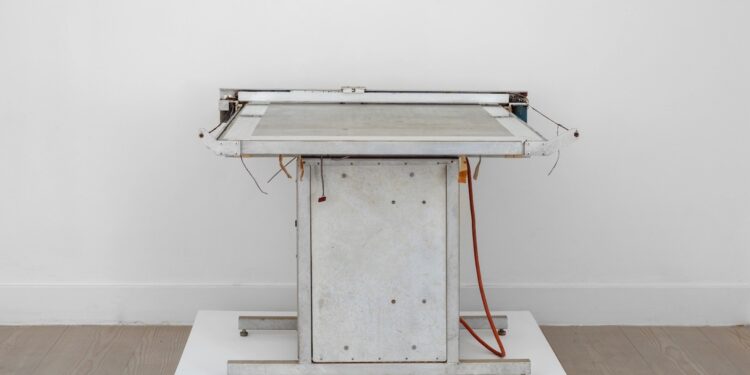Generative art may have its roots with dada artists in the early 20th century, but artist Harold Cohen is credited with pioneering the tech-based genre. He became one of the first practitioners of automated art when he built a code-run machine that could produce figurative paintings.
In the late ’60s, Cohen, a once-languishing painter, was working as a lecturer at the University of California in San Diego in the visual arts department. Around the same time, computer science researchers at the university were beginning to use artificial intelligence to break new ground in mathematics. Inspired, Cohen began exploring the use of computers in 1968 and, by the early ’70s, had built a computer system dubbed AARON to create paintings from pre-programmed algorithmic code.
He would eventually go on to unveil AARON, and the works deriving from it, at the Los Angeles County Museum of Art.
A new exhibition at the London gallery Gazelli Art House explores Cohen’s enduring contribution to art and technology. The showcase, titled “The AARON Retrospective,” comes two months after the London dealer announced representation of Cohen’s estate. The artist died in 2016 at the age of 87.
On view until November 16, the exhibition includes 18 works spanning Cohen’s figurative paintings, alongside the vintage steel machinery Cohen used to execute them. It is the second exhibition focused on Cohen’s work, the first of which was during its group showcase “Code of Arms” in 2021 that focused on the pioneering AI artist.
The works that Cohen produced with his then-nascent technology look little like the sleek, graphic aesthetic that is associated with today’s virtually-generated AI imagery. His varicolored paintings depict figures often gathered in collective leisure, as well as inquisitive portraits and abstract forms weaving together on hot pink backgrounds.
The gallery’s founder, Mila Askarova, told ARTnews that the show represents a “full circle” of what Cohen made during his decades-long career as he navigated his machine’s development. Cohen moved back and forth between abstracting forms and fleshing out figures as he continued to sharpen the program’s abilities. In canvases produced from the 1980s to the mid-2010s, groups of figures can be seen balancing in sync mid-exercise, while vibrant abstract forms mesh together in cartoonish outlays.
The retrospective look at Cohen’s work, Askarova says, brings up questions about “the autonomy of tech” and its promises of collective progress as the virtual landscape grows increasingly enmeshed into our reality.
“At every stage of AARON’s development, Cohen would analyze the extent to which the machine would operate autonomously and work with and on it accordingly. When AARON began to use color in the works, it introduced an element of chance,” said Askarova.
In 2002, according to Askarova, Cohen remarked, “I could not have predicted when I finally broke through my brick wall that AARON would become in many ways a better, a more vigorous colourist than I have ever been.”
Standing out like sculptural forms in the showcase are different editions of Cohen’s machine. One late 1960s bot called Turtle, a steel mechanism made of three stacked boxes with an analogue interface, appears through today’s lens to look like something out of a vintage sci-fi flick. Used for drawing, Turtle foregrounded the technology from which AARON was built.
For another machine produced later in 1980 called Drawing Machine (Arm), a robot made of steel copper and plastic, Cohen affixed an arm that levelled up its predecessor’s sketching skills.
The technologies “paved the way to the man-machine dialogue and collaborations happening to this day,” said Askarova.
Source: ARTnews


Recent Comments